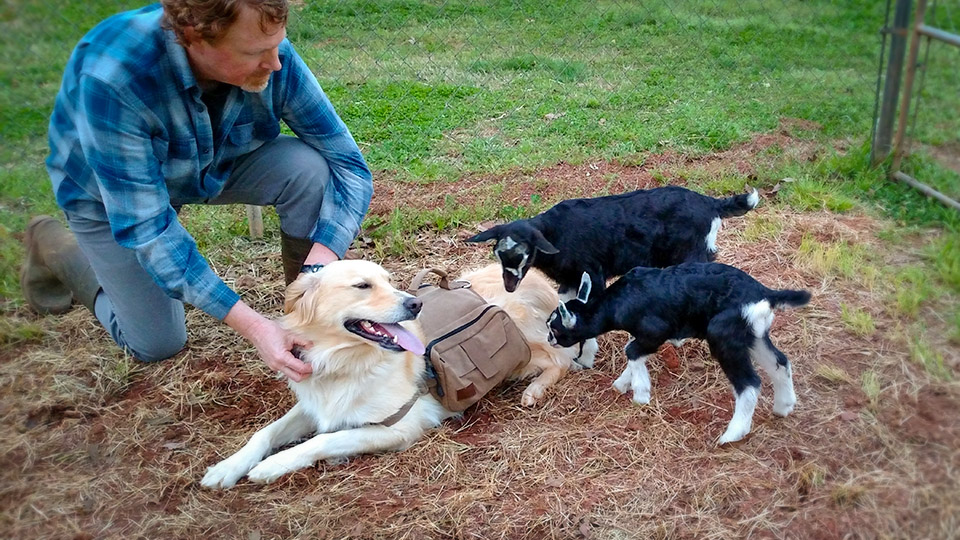In April 2021, we introduced two new members to our farm – Shalako and Hondo. They are Alpine wethers, coming to us from Spinning Spider Creamery nestled in a mountain cove on Bailey Mountain north of Ashville, North Carolina. Their Alpine herd consists of some Superior Genetics and Grand Champion animals – recognized for their exemplary production and breed conformation.
All that to say, Shalako and Hondo come from some fine stock and we think they will make great additions to our farm as well as strong future pack goats. They started out with personal attention by their breeders, and at one and three weeks old, came too our farm where we continued daily interaction.
Goat kids drink milk as their main source of nutrition. Not having a goat doe to produce the milk they needed, we had to find an alternate source. The consensus we heard from multiple breeders is that grocery store whole cow’s milk is the best source of disease-free milk. Johne’s disease can be passed through raw milk from either a cow or goat, so pasteurizing is highly recommended even if a raw milk source is available.
At first, Shalako and Hondo drank one pint of warm milk, three times a day. We spaced these feeding approximately eight hours apart. By a week old a goat kid will start taking an interest in bits of hay and some plants. We made some hay available and they nibbled on it and sampled various plants when we took them on walks.
Walking on trails is a major function of a pack goat, so we started them right away following us as we explored our property and surrounding trails through the woods. We also bought them medium dog harnesses to get them used to wearing something and making them easier to get a hold of if we needed to redirect them from unhealthy plants or ones we want to keep – like flowers around the house.
A wide range of opinion exists in all areas of goat management. The key seems to be to spend regular time observing your animal’s health and behavior to see how they are doing and make adjustments accordingly. We have read feeding goat kids milk too long can cause excess calcium deposits on the joints — something you definitely would not want for goats raised for a great deal of long-distance walking.
It will take additional time to form our own experience, but we started weaning after Hondo and Shalako were eight and eleven week old. We started weaning them from milk by reducing their milk at one feeding by 1/4 pint and replacing it with water – still providing it warm. We would reduce it until they were just having warm water at that feeding and then eliminate the feeding all together.
At the same time, they were eating more and more hay and browsing considerably within their pasture and on walks. Their body capacity is obviously growing into more of a wedge shape revealing that their complex four-stomach digestion system is developing and functioning well. When they are stilling on your lap you can hear their rumen, the first stage of their stomach, growling. They are also bringing up mouthfuls from there to chew again before sending it on to the rest of their digestive system.
In addition to an alfalfa/timothy grass hay mixture while they are growing, we are also providing a grain mixture twice a day and access to minerals. When we cannot take them on walks, we are bringing a bucket of kudzu, blackberry or other plentiful plants they like from surrounding fields.
While they will need to be a year old before introducing them to carrying much weight, and full maturity before starting to carry 1/4 of their weight, we are introducing them now to having a harness on their chest and shoulders, following us on the trail, and not jumping on us. Goat’s like to use their heads, so we are intentionally not pushing back on their heads to correct their behavior. We want them to know using their heads with humans is not acceptable.
Verbal commands such as “back up” are being used at the gate to have them stand back when we come and go from their pasture or bring in food. A spray bottle reinforces our words and they are catching on fairly quickly. We’ve read quite a bit of what Marc Warnke has written at Packgoats.com and are taking many of our queues from his experience.
At this point, we’re training Shalako and Hondo for our own use on the trail, but we’re also interested in gauging the interest in pack goats in the Eastern USA to see if others would like to buy trained pack goats for their day hikes or longer treks. If you have an interest in pack goats, we would love to hear from you.
